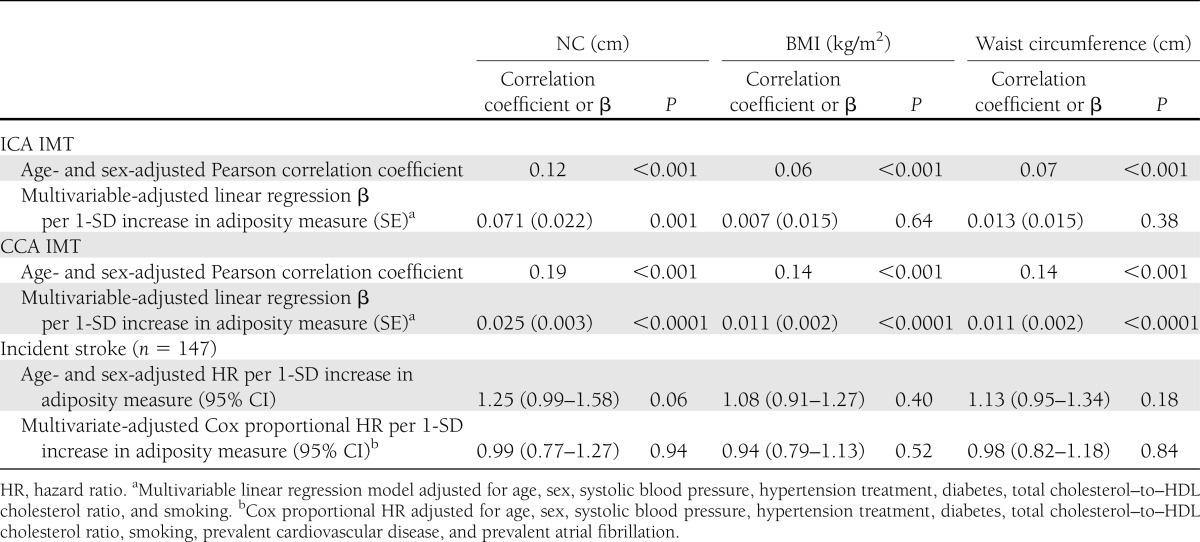Locally acting fat depots may contribute to obesity complications, in particular vascular disease, through direct paracrine effects (1,2). The carotid arteries are encased in fat, and total upper-body subcutaneous fat is estimated by neck circumference (NC). NC has been independently correlated with cardiometabolic risk factors above and beyond that of other adiposity measures (3,4). Carotid wall intima-media thickness (IMT) is a surrogate marker of subclinical atherosclerosis and has been associated with cardiovascular and stroke outcomes (5). The aim of this study was to evaluate the association of NC and carotid wall IMT above and beyond traditional cardiovascular risk factors and generalized adiposity.
Framingham Heart Study offspring participants who underwent carotid ultrasonography and NC measurements were included (n = 3,274; mean age 59 years; 52% women); NC, internal carotid artery (ICA) IMT, and common carotid artery (CCA) IMT were determined as previously described (4,5). Linear regression models evaluated the association between adiposity exposures and IMT. NC, BMI, and waist circumference were standardized to a mean of 0 and SD of 1 to make the β-coefficients comparable per 1-SD increase of each independent variable. We secondarily adjusted for sleep-disordered breathing from a self-assessment questionnaire. Cox proportional hazards models were used to assess the longitudinal association between adiposity measures and incident stroke.
NC, BMI, and waist were correlated with IMT (Table 1). In multivariable models, a 1-SD increase in NC was associated with a 0.071-mm increase in ICA IMT (P = 0.001), which remained significant after BMI adjustment (P < 0.0001). Neither BMI (P = 0.64) nor waist (P = 0.38) was associated with ICA IMT. The association between NC and ICA was similar and remained significant after adjustment for sleep. Per 1-SD increase in NC, the CCA was 0.025 mm higher (P < 0.001), which remained significant after BMI adjustment (P < 0.001). Significant but smaller associations were observed for BMI and waist, which were attenuated upon additional adjustment for NC. The association between NC and CCA was slightly attenuated (β = 0.017, P = 0.003) but remained significant after adjustment for sleep.
Table 1.
Comparison of outcomes based on NC, BMI, and waist circumference among 3,274 participants of the Framingham Heart Study offspring cohort

NC, BMI, and waist were not associated with incident stroke over 6.1 years of follow-up (n = 147 events); subgroup analysis excluding transient ischemic attacks and evaluating the outcomes by stroke type showed results similar to the primary analysis (data not shown).
NC, but neither BMI nor waist, was associated with ICA IMT. CCA IMT is preferentially associated with NC after adjustment for BMI and waist. Finally, NC, BMI, and waist were not associated with incident stroke. Strengths include a well-defined cohort with comprehensive clinical characterization. Some limitations warrant mention. Evaluation of sleep-disordered breathing was based on available data; more robust measures are needed to evaluate this association. The small number of stroke events and relatively short follow-up time may have limited our power. The correlation between NC and volumetric evaluation of upper-body subcutaneous fat has yet to be determined. This study was hypothesis generating and not intended to impact clinical practice. NC is uniquely associated with carotid IMT. Upper-body subcutaneous fat may have a direct pathogenic impact on local vasculature.
Acknowledgments
This research was conducted in part using data and resources from the Framingham Heart Study of the National Heart, Lung, and Blood Institute (NHLBI) of the National Institutes of Health and Boston University School of Medicine. This work was supported by the NHLBI's Framingham Heart Study (contract no. N01-HC-25195) and the National Institute of Neurological Disorders and Stroke (R01 NS17950). K.J.R. is supported through funding from the Whitaker Cardiovascular Institute (T32 HL007224). J.F.P. is supported by grants from the NHLBI (R01 HL069003 and HL081352). A.B., P.A.W., and S.S. are also supported by grants from the National Institute on Aging (R01 033193, 031287, 08122, and 33040).
No potential conflicts of interest relevant to this article were reported.
K.J.R. designed the study. J.M.M. and K.M.P. completed the statistical analyses and reviewed and edited the manuscript. R.B.D., A.B., G.T.O., C.J.O., and P.A.W. contributed to the discussion and reviewed and edited the manuscript. J.F.P. and S.S. provided the research data, contributed to the discussion, and reviewed and edited the manuscript. K.J.R. and C.S.F. designed the study, led the statistical analysis, and wrote the manuscript. K.J.R. and C.S.F. are the guarantors of this work and, as such, had full access to all the data in the study and take responsibility for the integrity of the data and the accuracy of the data analysis.
Parts of this study were presented in abstract form at the American Heart Association Epidemiology and Prevention/Nutrition, Physical Activity and Metabolism 2013 Scientific Sessions, New Orleans, Louisiana, 19–22 March 2013.
References
- 1.Eringa EC, Bakker W, van Hinsbergh VW. Paracrine regulation of vascular tone, inflammation and insulin sensitivity by perivascular adipose tissue. Vascul Pharmacol 2012;56:204–209 [DOI] [PubMed] [Google Scholar]
- 2.Fox CS, Massaro JM, Schlett CL, et al. Periaortic fat deposition is associated with peripheral arterial disease: the Framingham Heart Study. Circ Cardiovasc Imaging 2010;3:515–519 [DOI] [PMC free article] [PubMed] [Google Scholar]
- 3.Fitch KV, Stanley TL, Looby SE, Rope AM, Grinspoon SK. Relationship between neck circumference and cardiometabolic parameters in HIV-infected and non-HIV-infected adults. Diabetes Care 2011;34:1026–1031 [DOI] [PMC free article] [PubMed] [Google Scholar]
- 4.Preis SR, Massaro JM, Hoffmann U, et al. Neck circumference as a novel measure of cardiometabolic risk: the Framingham Heart Study. J Clin Endocrinol Metab 2010;95:3701–3710 [DOI] [PMC free article] [PubMed] [Google Scholar]
- 5.Polak JF, Pencina MJ, Pencina KM, O’Donnell CJ, Wolf PA, D’Agostino RB., Sr Carotid-wall intima-media thickness and cardiovascular events. N Engl J Med 2011;365:213–221 [DOI] [PMC free article] [PubMed] [Google Scholar]


